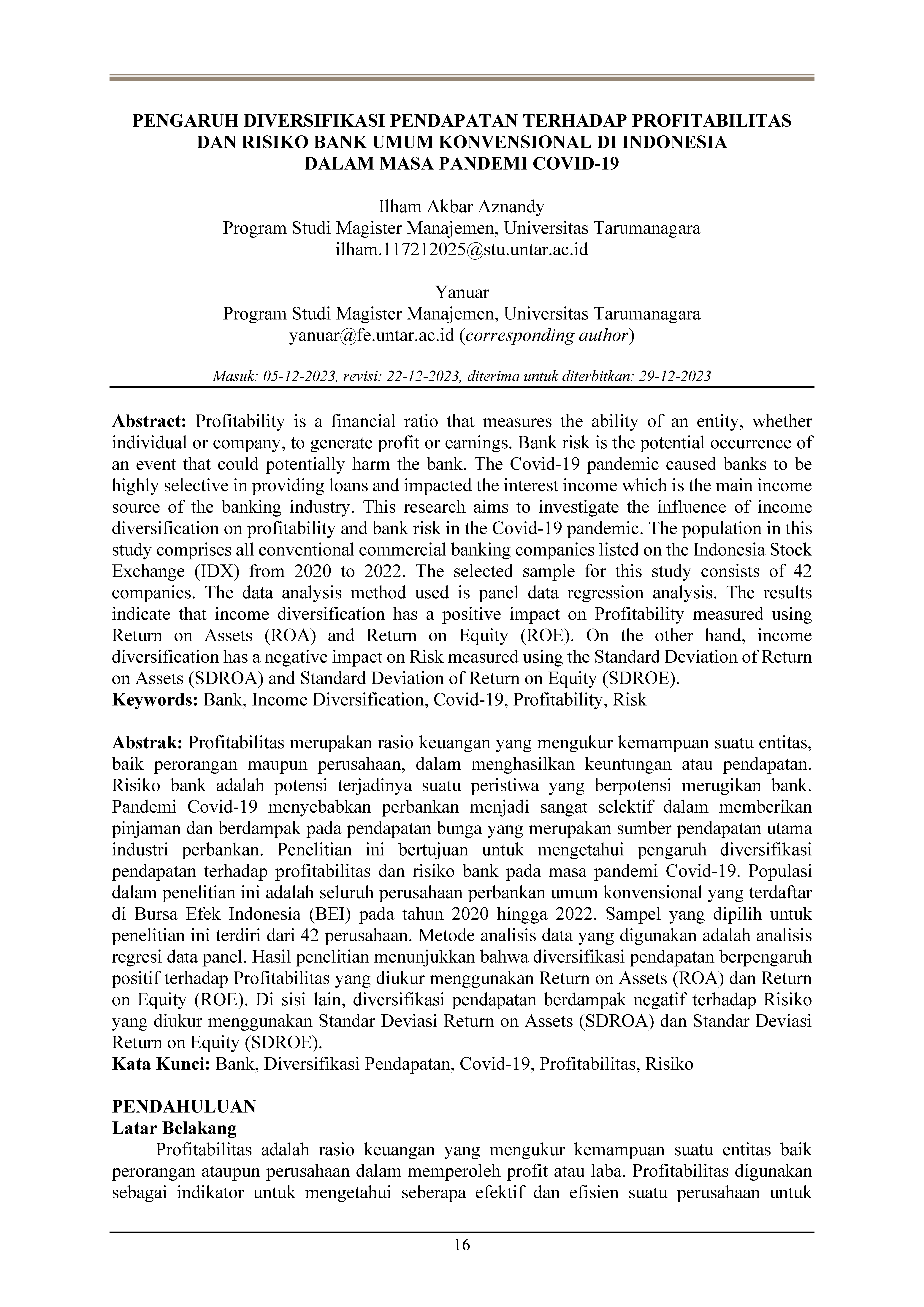Pengaruh diversifikasi pendapatan terhadap profitabilitas dan risiko bank umum konvensional di Indonesia dalam masa pandemi Covid-19
Main Article Content
Abstract
Profitability is a financial ratio that measures the ability of an entity, whether individual or company, to generate profit or earnings. Bank risk is the potential occurrence of an event that could potentially harm the bank. The Covid-19 pandemic caused banks to be highly selective in providing loans and impacted the interest income which is the main income source of the banking industry. This research aims to investigate the influence of income diversification on profitability and bank risk in the Covid-19 pandemic. The population in this study comprises all conventional commercial banking companies listed on the Indonesia Stock Exchange (IDX) from 2020 to 2022. The selected sample for this study consists of 42 companies. The data analysis method used is panel data regression analysis. The results indicate that income diversification has a positive impact on Profitability measured using Return on Assets (ROA) and Return on Equity (ROE). On the other hand, income diversification has a negative impact on Risk measured using the Standard Deviation of Return on Assets (SDROA) and Standard Deviation of Return on Equity (SDROE).
Profitabilitas merupakan rasio keuangan yang mengukur kemampuan suatu entitas, baik perorangan maupun perusahaan, dalam menghasilkan keuntungan atau pendapatan. Risiko bank adalah potensi terjadinya suatu peristiwa yang berpotensi merugikan bank. Pandemi Covid-19 menyebabkan perbankan menjadi sangat selektif dalam memberikan pinjaman dan berdampak pada pendapatan bunga yang merupakan sumber pendapatan utama industri perbankan. Penelitian ini bertujuan untuk mengetahui pengaruh diversifikasi pendapatan terhadap profitabilitas dan risiko bank pada masa pandemi Covid-19. Populasi dalam penelitian ini adalah seluruh perusahaan perbankan umum konvensional yang terdaftar di Bursa Efek Indonesia (BEI) pada tahun 2020 hingga 2022. Sampel yang dipilih untuk penelitian ini terdiri dari 42 perusahaan. Metode analisis data yang digunakan adalah analisis regresi data panel. Hasil penelitian menunjukkan bahwa diversifikasi pendapatan berpengaruh positif terhadap Profitabilitas yang diukur menggunakan Return on Assets (ROA) dan Return on Equity (ROE). Di sisi lain, diversifikasi pendapatan berdampak negatif terhadap Risiko yang diukur menggunakan Standar Deviasi Return on Assets (SDROA) dan Standar Deviasi Return on Equity (SDROE).
Article Details

This work is licensed under a Creative Commons Attribution-NonCommercial-ShareAlike 4.0 International License.
This work is licensed under a Jurnal Manajemen Bisnis dan Kewirausahaan Creative Commons Attribution-ShareAlike 4.0 International License.
References
Berger, A. N., Hasan, I., & Zhou, M. (2010). The effects of focus versus diversification on bank performance: Evidence from Chinese banks. Journal of Banking and Finance, 34(7), 1417–1435. https://doi.org/10.1016/j.jbankfin.2010.01.010
Boyd, J. H., & De Nicoló, G. (2005). The theory of bank risk taking and competition revisited. Journal of Finance, 60(3), 1329–1343. https://doi.org/10.1111/j.1540-6261.2005.00763.x
DeYoung, R., & Torna, G. (2013). Nontraditional banking activities and bank failures during the financial crisis. Journal of Financial Intermediation, 22(3), 397–421. https://doi.org/10.1016/j.jfi.2013.01.001
Gubernur Bank Indonesia. (2011). Peraturan Bank Indonesia Nomor 13/23/PBI/2011 tentang Penerapan Manajemen Risiko bagi Bank Umum Syariah dan Unit Usaha Syariah. https://www.bi.go.id/id/publikasi/peraturan/Pages/pbi_132311.aspx
Haron, H., Chambers, A., Ramsi, R., & Ismail, I. (2004). The reliance of external auditors on internal auditors. Managerial Auditing Journal, 19(9), 1148–1159. https://doi.org/10.1108/02686900410562795
Hidayat, W. Y., Kakinaka, M., & Miyamoto, H. (2012). Bank risk and non-interest income activities in the Indonesian banking industry. Journal of Asian Economics, 23(4), 335–343. https://doi.org/10.1016/j.asieco.2012.03.008
Hsiao, C. (2007). Panel data analysis - Advantages and challenges. Test, 16(1), 1–22. https://doi.org/10.1007/s11749-007-0046-x
Kamus Besar Bahasa Indonesia (KBBI). (2023). Diversifikasi. https://kbbi.web.id/diversifikasi
Köhler, M. (2015). Which banks are more risky? The impact of business models on bank stability. Journal of Financial Stability, 16, 195–212. https://doi.org/10.1016/j.jfs.2014.02.005
Kumbirai, M., & Webb, R. (2010). A financial ratio analysis of commercial bank performance in South Africa. African Review of Economics and Finance, 2(1), 30–53. https://www.ajol.info/index.php/aref/article/view/86945
Lee, C. C., Yang, S. J., & Chang, C. H. (2014). Non-interest income, profitability, and risk in banking industry: A cross-country analysis. North American Journal of Economics and Finance, 27, 48–67. https://doi.org/10.1016/j.najef.2013.11.002
Li, X., Feng, H., Zhao, S., & Carter, D. A. (2021). The effect of revenue diversification on bank profitability and risk during the COVID-19 pandemic. Finance Research Letters, 43, 101957. https://doi.org/10.1016/j.frl.2021.101957
Lipunga, A. M. (2014). Determinants of profitability of listed commercial banks in developing countries: Evidence from Malawi. Research Journal of Finance and Accounting, 5(6), 41–49. https://iiste.org/Journals/index.php/RJFA/article/view/11909
Markowitz, H. (2009). Portfolio selection. Harry Markowitz: Selected Works, 7(1), 15–30. https://doi.org/10.2307/2975974
Maudos, J. (2017). Income structure, profitability and risk in the European banking sector: The impact of the crisis. Research in International Business and Finance, 39, 85–101. https://doi.org/10.1016/j.ribaf.2016.07.034
Mercieca, S., Schaeck, K., & Wolfe, S. (2007). Small European banks: Benefits from diversification? Journal of Banking and Finance, 31(7), 1975–1998. https://doi.org/10.1016/j.jbankfin.2007.01.004
Morris, C. S., & Regehr, K. (2014). What explains low net interest income at community banks? Economic Review - Federal Reserve Bank of Kansas City, 5–33. https://www.proquest.com/docview/1557523994?sourcetype=Scholarly Journals
Nisar, S., Peng, K., Wang, S., & Ashraf, B. N. (2018). The impact of revenue diversification on bank profitability and stability: Empirical evidence from South Asian countries. International Journal of Financial Studies, 6(2), 40. https://doi.org/10.3390/ijfs6020040
Otoritas Jasa Keuangan. (2016). Peraturan Otoritas Jasa Keuangan Nomor 18/POJK.03/2016 tentang Penerapan Manajemen Risiko bagi Bank Umum. https://www.ojk.go.id/id/kanal/perbankan/regulasi/peraturan-ojk/Documents/Pages/POJK-Nomor-18.POJK.03.2016/SAL - POJK Manajemen Risiko .pdf
Otoritas Jasa Keuangan. (2021). Laporan tahunan OJK 2020. https://ojk.go.id/id/data-dan-statistik/laporan-tahunan/Pages/Laporan-Tahunan-OJK-2020.aspx
Presiden Republik Indonesia. (1998). Undang-undang Republik Indonesia Nomor 10 Tahun 1998 tentang Perubahan atas Undang-undang Nomor 7 Tahun 1992 tentang Perbankan. https://www.bphn.go.id/data/documents/98uu010.pdf
Stiroh, K. J. (2004). Diversification in banking: Is noninterest income the answer? Journal of Money, Credit and Banking, 36(5), 853–882. https://doi.org/10.2139/ssrn.334420
Wang, C., & Lin, Y. (2021). Income diversification and bank risk in Asia Pacific. North American Journal of Economics and Finance, 57, 101448. https://doi.org/10.1016/j.najef.2021.101448
Zhang, A., Wang, S., Liu, B., & Fu, J. (2020). The double-edged sword effect of diversified operation on pre- and post-loan risk in the government-led Chinese commercial banks. North American Journal of Economics and Finance, 54, 101246. https://doi.org/10.1016/j.najef.2020.101246


